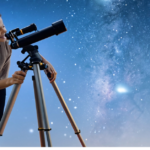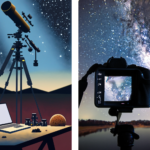Choosing a telescope is challenging for both the beginner and the advanced astrophotographer. There are many different kinds of telescopes. In this post, we will focus on two, the Dobsonian vs Cassegrain telescopes, and compare them to see which is the best choice for astrophotographers.
Which of these two telescopes is better for astrophotography? First, let’s look at telescopes in general. Then we will consider how to choose between a Dobsonian vs Cassegrain telescope.

A brief overview of Telescopes
Telescopes have been around for a long time. They have been and continue to be very important tools in astronomy. The first telescope was made in 1608 by the Dutchman Hans Lipperhey. When and how it was invented is not known. Galileo made his own telescope after hearing about the first scope made in Holland.
Galileo made many important scientific discoveries with telescopes. These included the discovery of the four moons of Jupiter, the fact that the Earth was round, and others. Click through to the website of the Royal Observatory at Greenwich to learn more.
The importance of telescopes for astronomy
To date, the most expensive telescope is the James Webb Telescope. It is currently operating in outer space. It can see further than any previous telescope. It cost a staggering 10 billion dollars!
Telescopes are important in astronomy because they allow us to see distant objects such as galaxies, nebulae, planets, and stars. They are a great tool for astrophotography. Telescopes allow us to take photographs of deep-sky objects that we could not see with our eyes alone.
Different types of telescopes are available
There are two important types of telescopes: reflectors and refractors. Both professionals and amateurs use these. These types of telescopes are divided into different designs that have different uses.
The importance of choosing the right telescope
You can use a telescope for observation or for astrophotography. But the choice you make is very important. It may affect the quality and type of work you can do with it. Choosing the wrong model or design can be an expensive and frustrating mistake. So, it is always worth taking time to research what you need and what you plan to do with your telescope. Check out this helpful page I wrote with my choice of the eight best telescopes you could use.
Impact on astrophotography
There are many features of a telescope that can affect astrophotography. Generally, we don’t need high magnification, but the focal length is important. This changes the field of view and the image that we capture. In order to capture an object that appears small in size, we need a longer focal length.
As an example, I sometimes shoot galaxies such as M109 or M94, which appear very small in my telescope. The focal length of my scope is 650mm. If I wanted to get closer to the galaxy, I would need a longer focal length, perhaps more than 1000mm. The magnification increases as the focal length gets longer.
However, the aperture size of a telescope is more important because then more light will be collected and more detail of the object is possible. A larger aperture will also enable us to see more faint detail.
Certain types of telescopes may be more suitable for particular types of astrophotography. Lenses are a big part of that.
For viewing the planets a Cassegrain telescope like the Celstron 8 SE is one of the best stargazing telescopes there is.
The best telescope for stargazing in general is a dobsonian because they have large apertures and let in lots of light.
In the next section, we’ll take a close look at the differences between Dobsonian vs Cassegrain telescopes. Then we’ll consider what this means for their use in astrophotography.
Financial investment
According to this website, Dobsonians are cheaper than Cassegrains. The average price given by Opticsidea.com is $500–$1300 for a Dobsonian. This compares to $2200–4499 for a Cassegrain. So, there is quite a difference in price!
I did some research on these prices myself. I found the following to check whether the above figures are accurate (prices in 2023):
| Type of Telescope | Price Given | Source |
| Dobsonian | $500 | odysseymagazine.com |
| Dobsonian | $460-4680 | skiesunlimited.com |
| Cassegrain OTA | $839-3199 | skiesunlimited.com |
| Dobsonian | $599-2899 | Orion.com |
| Cassegrain OTA | $699-7999 | Orion.com |
| Dobsonian | $499-1099 | Amazon.com |
| Cassegrain | $599-2199 | Amazon.com |
From the above table, we can see that it is true that Dobsonians are generally cheaper. The figures given by Opticside are accurate. Yet, there are many more expensive models of both kinds of telescopes available.
Dobsonian Telescopes
My Top 3 Recommendations:
| Image | Product | Features | Price |
|---|---|---|---|
 |
| Shop at Amazon | |
 |
| Shop at Amazon | |
 |
| Shop at Amazon |
In 1960, John Dobson invented the Dobsonian telescope to be easy to use.
It is a reflector telescope with a simple design that is cheap compared to many other telescopes. Because of its low cost and ease of use, this kind of telescope is very popular among astronomers.
The design of the Dobsonian telescope is based on standard reflectors. There is a primary mirror that collects the light. A secondary mirror then reflects this light into an eyepiece on the side of the scope.
The primary mirror is a parabolic one made of either glass or reflective material. This mirror collects light from astronomical objects. The larger the mirror, the more light it can collect, so details and resolution improve. As with all reflectors, this main mirror lies at the bottom of a tube opposite the open aperture.
A secondary mirror at the upper end of the tube reflects light from the primary mirror to the eyepiece. This mirror is usually flat or slightly curved. This secondary mirror is much smaller than the primary. A spider-like support holds it in place.
The Dobsonian telescope normally has a simple alt-azimuth mount that is easy to use. This kind of telescope is best for observing deep-sky and other objects.
Advantages and Disadvantages of the Dobsonian
Pros
There are several advantages to a Dobsonian telescope, including:
- Lower cost
- Larger aperture
- Easier to use
Cons
- Bulky and heavy
- Not such good tracking ability
- Not suitable for astrophotography
Who is it for?
- Beginners
- Amateurs
- Those who can’t afford more expensive equipment
- Those wanting to use a telescope for observation
- Those with limited space
Best Used For
- Deep-sky observation
- Lunar and planetary observations
Cassegrain Telescopes

This is also a kind of reflector telescope. It also has two mirrors, a primary and a secondary. But there are some differences compared to the design of a Dobsonian telescope.
The above image is a particular kind of scope, the Masukov-Cassegrain.
Andrew Wilson, who writes for the British Astronomical Association website, explained this to me:
“Cassegrain refers to a very specific design that does not include a corrector plate. They are very good for planetary observation, but in their pure form, they are not so good for deep sky. Meade, Celestron, and other manufacturers produce telescopes in a variety of designs termed catadioptric telescopes. These have corrector plates at the front or corrector lenses near the eyepiece end and are a mix of Maksutov-Cassegrain, Schmidt-Cassegrain, and variants on the Ritchey-Chretien design. For example, the one in your image is a Maksutov-Cassegrain.”
The primary mirror is concave, and the secondary one is smaller and convex. The primary mirror is parabolic in form. The secondary mirror reflects light from the primary mirror. This light goes back up the tube and through a hole in the primary mirror. The eyepiece is now not on the side but at the end outside the telescope tube at the focal point.
The design of the Cassegrain telescope creates a longer focal length. This increases magnification and creates a smaller field of view.
The Cassegrain telescope can have either an equatorial or alt-az mount. This makes it more versatile.
But now that you know all this, how do you choose the Cassegrain telescope that is best for you? I recommend you read this book before making your decision:
Advantages and Disadvantages
Pros
- Compact and portable
- Higher magnification
- Good for astrophotography
Cons
- Cost more than other telescopes
- The aperture is smaller
- More difficult to use
Ideal Users
- Intermediate and more advanced users
- Those wanting to use a telescope for observation
- Astrophotographers
Best Uses for Cassegrains
- Planetary and Lunar observation
- Deep-sky observation
- Astrophotography
Comparing Dobsonian vs Cassegrain Telescopes
Which should you choose?
| Dobsonian | Cassegrain |
| Cheaper | More expensive |
| Lighter | Heavier |
| Smaller | Larger |
| Better Image | Less clear |
| Easier to use | Slightly more difficult to use |
| Less magnification | More magnification |
| Not as good for planetary observation | Better for planetary work |
| Not for astrophotography | For astrophotography |
| Not such good tracking | Good tracking |
Conclusion
Each of these two telescopes has its own uses and features, which will appeal to different users. Dobsonian vs Cassegrain? In the end, your choice depends on what you want to do with it. For astrophotography, it is better to go for a Cassegrain. But for a beginner on a tight budget, a Dobsonian is a better choice. Think carefully before spending your money and making your choice!







